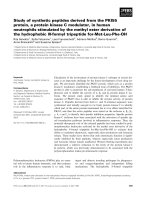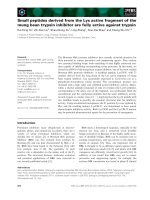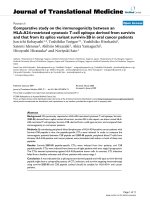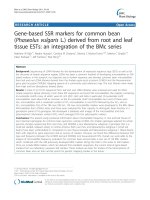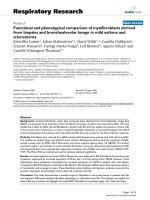Circular aromatic gamma peptides derived from phenol and methoxybenzene based building blocks
Bạn đang xem bản rút gọn của tài liệu. Xem và tải ngay bản đầy đủ của tài liệu tại đây (1.49 MB, 69 trang )
CIRCULAR AROMATIC Γ-PEPTIDES DERIVED
FROM PHENOL- AND METHOXYBENZENE-BASED
BUILDING BLOCKS
SHU YINGYING
(B.Sc.), SICHUAN UNIVERSITY, CHINA
A THESIS SUMBITTED
FOR THE DEGREE OF MASTER OF SCIENCE
DEPARTMENT OF CHEMISTRY
NATIONAL UNIVERSITY OF SINGAPORE
2009
Acknowledgements
I would like to express my sincere gratitude to my supervisor, Dr. Zeng Huaqiang, Ph. D.,
Assistant Professor, Department of Chemistry, National University of Singapore, for his
valuable guidance, persistent help and encouragement throughout these years. He conveys
a spirit of adventure in regard to research and devotes considerable amount of time to guide
students in the projects, not only sharing his knowledge but also inspiring students to
contribute to knowledge.
I would like to express my sincere thanks to Dr. Qin Bo, Research Fellow, and Sun Chang
for their valuable and kind help in my project. And I would also like to thank the other
members in Dr. Zeng’s group, Yan Yan, Fang Xiao, Ong Wei Qiang, Ren Changliang, Yip
Yeow Kwan, Hii Meng Ni, Liang Hui Fang and Pan Si Yan, for their collaboration and
friendship.
I would like to express my sincere gratitude to Department of Chemistry and National
University of Singapore for the award of the research scholarship.
In addition, I am so grateful for the moral support and warmest encouragement from my
parents and friends to complete the project. Thank you all.
Shu Yingying
i
Table of Contents
ACKNOWLEDGEMENTS............................................................................................................ I
TABLE OF CONTENTS...............................................................................................................II
SUMMARY .................................................................................................................................... V
LIST OF TABLES ...................................................................................................................... VII
LIST OF FIGURES .................................................................................................................. VIII
LIST OF ILLUSTRATIONS ........................................................................................................ X
CHAPTER ONE: INTRODUCTION............................................................................................1
1.1 GENERAL .................................................................................................................................1
1.2 UNIMOLECULAR ION CHANNEL ................................................................................................4
1.3 AGGREGATE ION CHANNELS ....................................................................................................6
1.4 OTHER TYPES OF ION CHANNELS ...........................................................................................12
1.5 APPLICATIONS ........................................................................................................................13
REFERENCES ................................................................................................................................15
CHAPTER TWO: SYNTHESIS AND STRUCTURAL INVESTIGATIONS OF CIRCULAR
AROMATIC Γ-PEPTIDES DERIVED FROM PHENOL- AND
METHOXYBENZENE-BASED BUILDING BLOCKS............................................................18
2.1 INTRODUCTION ......................................................................................................................18
2.2 EXPERIMENTAL SECTION .......................................................................................................20
ii
2.2.1 Synthetic Scheme ...........................................................................................................20
2.2.2 General Methods ...........................................................................................................22
2.2.3 Synthetic Procedure .......................................................................................................22
2.3 THEORETICAL MODELING ......................................................................................................33
2.3.1 Dimer.............................................................................................................................33
2.3.2 Higher Oligomers from Trimer to Pentamer .................................................................34
2.3.3 Cyclic Pentamers...........................................................................................................35
2.4 RESULTS AND DISCUSSION .....................................................................................................36
2.4.1 Synthesis of Monomer, Higher Oligomers and Cyclic Pentamers .................................36
2.4.2 1D and 2D 1H NMR Results ..........................................................................................40
2.4.3 X-Ray Crystal Structure Analysis...................................................................................41
2.5 CONCLUSIONS ........................................................................................................................43
REFERENCES ................................................................................................................................44
CHAPTER THREE: SYNTHESIS AND STRUCTURAL INVESTIGATIONS OF
METHOXYBENZENE-BASED CIRCULAR Γ-PEPTIDES....................................................45
3.1 INTRODUCTION ......................................................................................................................45
3.2 EXPERIMENTAL SECTION .......................................................................................................45
3.2.1 Synthetic Schemes..........................................................................................................45
3.2.2 General Methods ...........................................................................................................47
3.2.3 Synthetic Procedure .......................................................................................................48
3.3 THEORETICAL MODELING ......................................................................................................54
3.4 RESULTS AND DISCUSSION .....................................................................................................55
iii
3.4.1 Synthesis of Oligomers and Circular Pentamer.............................................................55
3.4.2 X-Ray Crystal Structure Analysis...................................................................................55
3.5 CONCLUSIONS ........................................................................................................................56
REFERENCES ................................................................................................................................58
iv
Summary
The aim of this project is to establish a new class of macrocyclic aromatic γ-peptides
derived from methoxybenzene- and phenol-based building blocks. These circular
γ-peptides with good ion-binding selectivities will be attached to some linear scaffolds,
potentially leading to the formation of synthetic ion channels with tunable interior
properties that may possess the function of selective ion transport in lipid bilayer
membrane.
According to the designed structure, the backbone involves the alternative arrangement of
aromatic building blocks and amide functionalities in which the free rotation of amide
bonds is restricted by hydrogen-bonding interactions. The utilization of bifurcated
hydrogen bond rigidifies the molecule and enforces the molecule to stay in a crescent
conformation, which is the key design principle of this project. The circular γ-peptides have
five monomeric building blocks which are derived from methoxybenzene or phenol
moieties. Therefore, the cavity formed is decorated by -OCH3 groups or –OH groups. The
oxygen atoms in these groups are supposed to serve as anion donors so that the circular
peptides may selectively bind cations and facilitate ion transport in the future study.
Both experimental synthesis and theoretical modeling were carried out to testify the design.
And results of X-ray crystallography and 2D NOESY collectively show the curved
conformation of the oligomers or the circular γ-peptide in solid state and solution state,
v
demonstrating the rationality and validity of our design principle. Further study of the
function of the circular γ-peptides needs to be carried out.
vi
List of Tables
TABLE 2.1 EXPRIMENT CONDITIONS OF DEBENZYLATION THAT HAVE BEEN TRIED. ..........................39
vii
List of Figures
FIGURE 1.1 ION CHANNELS FORMED BY NATURAL COMOUNDS. ................................................2
FIGURE 1.2 SCHEMATIC OF A VOLTAGE CLAMP EXPERIMENT. ....................................................4
FIGURE 1.3 SYNTHETIC CATION CHANNEL “HYDRAPHILES” CREATED BY GOKEL ET AL .............5
FIGURE 1.4 THE ION CHANNEL FORMED BY HYDRAPHILES........................................................5
FIGURE 1.5 SCHEME OF POST-MODIFICATION OF G-QUADRUPLEX.............................................6
FIGURE 1.6 AGGREGATION ION CHANNEL FORMED BY THE STACKING OF MACROCYCLES .........7
FIGURE 1.7 CYCLO[-(TRP-D-LEU)3GLM-D-LEU-] AND THE ION CANNEL IT FORMED IN LIPID
BILAYER ............................................................................................................................7
FIGURE 1.8 MACROCYCLES THAT CAN STACK TO FORM TUBULAR ION CHANNELS. ...................8
FIGURE 1.9 STRUCTURE OF CUCURBITURIL ..............................................................................9
FIGURE 1.10 Β-BARREL ION CHANNEL WITH RIGID-ROD SCAFFOLD ..........................................9
FIGURE 1.11 SCHEME OF PHOTOSYSTEM 1 PHOTO-SWITCHED INTO ION CHANNEL 2................10
FIGURE 1.12 AGGREGATE ION CHANNELS FROM AMPHIPHILES ...............................................10
FIGURE 1.13 A FEW EXAMPLES OF BOLAAMPHIPHILES ............................................................ 11
FIGURE 1.14 MICELLE-LIKE CHANNEL FORMED BY SINGLE CHAIN AMPHIPHILES ....................12
FIGURE 1.15 STRUCTURE OF SIMPLE COMPOUNDS THAT CAN FORM ION CHANNELS ................12
FIGURE 1.16 STRUCTURE OF ΑN AMINOXY ACID WHICH CAN FORM CHLORIDE CHANNELS .....13
FIGURE 2.1 CONCEPTUAL DEPICTION OF THE SYNTHETIC ION CHANNEL EMBEDDED WITHIN A
LIPID BILAYER MEMBRANE ..............................................................................................19
FIGURE 2.2 THE STRUCTURE OF 1F PREDICTED BY AB INTIO CALCULATION .............................34
viii
FIGURE 2.3 THE STRUCTURE OF TRIMER 1H PREDICTED BY AB INTIO CALCULATION ................34
FIGURE 2.4 THE STRUCTURE OF TETRAMER 1J PREDICTED BY AB INTIO CALCULATION ...........35
FIGURE 2.5 (A) TOP VIEW AND (B) SIDE VIEW OF THE STRUCTURE PREDICTED BY AB INTIO
CALCULATION OF CYCLIC PENTAMER 1. ..........................................................................35
FIGURE 2.6 (A) TOP VIEW AND (B) SIDE VIEW OF THE STRUCTURE PREDICTED BY AB INTIO
CALCULATION OF CYCLIC PENTAMER 1O .........................................................................36
FIGURE 2.7 TLC FOR CONDITIONS FROM ENTRY 1-10 .............................................................38
FIGURE 2.8 1D 1H NMR OF (A) PENTAMER 1L, (B) TETRAMER 1J, (C) TRIMER 1H AND (D) DIMER
1F IN CDCL3 (298 K, 5 MM). ..........................................................................................40
FIGURE 2.10 2D NOESY RESULT OF CIRCULAR PENTAMER 1 (298 K, 500 MS, 20 MM) ..........41
FIGURE 2.11 CRYSTAL STRUCTURE OF DIMMER (COMPOUND 1F) ............................................42
FIGURE 2.12 HYDROGEN BONDING IN DIMER 1F IN (A) AB INTIO CALCULATED STRUCTURE AND
(B) X-RAY CRYSTAL STRUCTURE ....................................................................................42
FIGURE 3.1 (A) TOP VIEW AND (B) SIDE VIEW OF THE STRUCTURE PREDICTED BY AB INTIO
CALCULATION OF CYCLIC PENTAMER 2...........................................................................54
FIGURE 3.2 (A) TOP VIEW AND (B) SIDE VIEW OF CRYSTAL STRUCTURE OF CIRCULAR PENTAMER
2 (THE METHYL GROUPS ARE REMOVED FOR CLARITY). ..................................................56
FIGURE 3.3 (A) TOP VIEW AND (B) SIDE VIEW OF THE CRYSTAL STRUCTURE OF 2 IN CPK
REPRESENTATIONS..........................................................................................................56
ix
List of Abbreviations
CHCl3
Chloroform
CDCl3
Deuterated Chloroform
DCM
Dichloromethane
DIEA
N, N-Diisopropylethylamine
DMF
N, N-Dimethylformamide
DMSO
Dimethyl sulfoxide
DMSO-d6
Deuterated Dimethyl Sulfoxide
EA
Ethyl Acetate
EtOH
Ethanol
MeOH
Methanol
NMM
N-Methylmorpholine
NMR
Nuclear Magnetic Resonance
Pd/C
Palladium on Carbon
THF
Tetrahydrofuran
1D
1-Dimensional
2D
2-Dimensional
x
Chapter One: Introduction
1.1 General
Ion transport through lipid bilayer membranes has always been a fascinating research topic
among researchers, perticularly supramolecular chemists. In nature, ion transport occurs
through ion carriers and ion channels. The former moves through the membrane together
with ions; while the latter stays with the membrane and let ions flow through. Early efforts
on mimicking the highly functionalized and sophisticated ion transporter were focused on
ion carriers1. In spite of that, natural ion channels have also inspired supramolecular
chemists for a long time. As long as 27 years ago, Tabushi2 and Nolte3 independently
reported synthetic ion channels for the first time. After that, the first crystal structure of
natural occurring ion channel--the potassium channel was revealed in 19984, which had
profoundly enriched the understanding of ion channel transport mechanism. Thereafter,
more and more synthetic ion channels have been created.
Besides the hints given by natural ion channels, molecules which are membrane-active and
functional as ion transporters inspired us substantially. For example, Gramicidin, a
pentadecapeptide made up of alternating D- and L- amino acids, dimerize to form β-helix in
lipid bilayer membrane. And amphotericin, a polyene antibiotic, aggregates end-to-end in
lipid bilayer membrane to form a membrane-spanning channel (Figure 1.11). These two
types of structure potently represent two major strategies for the design of synthetic ion
channels, known as “unimolecular ion channel” and “aggregate ion channel”. Although the
1
ion channel formed by Gramicidin is the product of dimerization, here we regard it as a
paradigm of unimolecular ion channels.
Figure 1.1 Ion channels formed by natural compounds. Gramicidin forms β-helix in
membrane. Amphotericin forms an aggregate channel in membrane.
Inspiring from nature, various biomimetic ion channels have been created, either with well
defined tubular structure or with the association of small components
1, 5, 6
. Although the
strategies are fairly different, all of the synthetic ion channels need to meet certain design
criteria for ion transport in lipid bilayer membranes. (1) Membrane-spanning structure
with the length of 3-4 nm given that lipid bilayer membrane is about 4 nm thick and the
hydrophobic core is about 3-3.5 nm. (2) Encompassment of a sufficient volume for the
passage of the ion. (3) Stabilizing contacts for the transporting ion. (4) The ability to embed
into a lipid bilayer membrane.
2
There are mainly two ways for the investigation of synthetic ion channels: vesicles (or
liposomes) and planar bilayer membranes. When vesicles are used, pH-sensitive or
ion-selective fluorescence dyes are employed to deduce the internal ionic composition.
Sodium NMR spectroscopy can also be used in this case through a line-shape analysis
method. A proper paramagnetic relaxation agent is able to produce a difference of chemical
shift between internal sodium ions and outer sodium ions of the vesicle. And the addition of
a membrane active channel can result in a corresponding change of the signal. Also the line
width and peak shape will be altered. Through the analysis of signals, the exchange rate
constant can be calculated. But it is better to use ion-selective electrodes via a pH-stat
kinetic method to directly measure the exchange rate constant or the concentration.
When planar bilayer membranes are used, the voltage clamp technique, which was initially
used for natural ion channels, is adopted. During the voltage clamp experiment, a constant
transmembrane potential is applied. Therefore the current changes are monitored as a
function of time (Figure 1.2). Very little current of the membrane is observed. When the
cannel opens, a current is produced due to the ionic flux. When the channel closes, the
current falls back.
3
Figure 1.2 Schematic of a voltage clamp experiment. (a) cuvette;(b) electrolyte;(c) Agar
salt-bridges;(d) reference electrolyte;(e) electrical contacts with reference electrolyte
1.2 Unimolecular ion channel
A series of synthetic ion channels called hydraphiles, which consist of several crown ether
units and side arms, are most typical among the unimolecular ion channels as shown in
Figure 1.3. There are three aza-crown ethers in channel 1, in which the ones at two ends are
act as headgroups to anchor the channel properly in the membrane. The three crowns were
initially expected to stack co-facially to form a tubular channel so that ions could flow
through the three circles. Experiments showed that the ion channel was active for cations.
When the central macrocycle changed to smaller crown ethers, the channels were still
active. This result showed that the cations did not pass through the central macrocycle. It
was assumed that donor groups in the central macrocycle could stabilize the cation in
transit. The hypothetic conformation of the channel is shown in Figure 1.4. It was later
proved by fluorescence experiments using the dansyl derivative 1d7. Another observation
was that channel 2 was more active than channel 1. It suggested that the increase of cation
donors enhanced the activity.
4
Figure 1.3 Synthetic cation channel “hydraphiles” created by Gokel et al
Figure 1.4 The ion channel formed by hydraphiles. The central macrocycle is along the
direction which the ion flows through.
To confirm the function of these channels, patch clamp technique was used and planar
bilayer conductance measurements were carried out to test the transport of alkali-metal
cation7. With Gramicidin as the control, the exchange rate of sodium ion through
phospholipid bilayer of vesicles was detected by 23Na NMR. The result showed that it was
concentration dependent. For channel 1, the exchange rate of sodium ion was about 27% of
that of gramicidin.
5
In recent years, it was discovered that G-quartet might serve as a scaffold for building
synthetic ion channels8. Even though the noncovalent assembly is thermodynamically
stable, there is dynamic equilibrium between individual guanosine and its hexadecamer in
solution. To fundamentally avoid the kinetic instability, post-assembly modification was
carried out. Using Olefin metathesis to cross-link subunits turned the assembly into a
unimolecular G-quadruplex (Figure 1.5) 9. According to the experiments of pH gradient
assay and 23Na NMR, the unimolecular G-quadruplex obviously fulfiled the transport of
Na+ ions across phospholipid bilayer membranes.
Figure 1.5 Scheme of post-modification of G-quadruplex. The G-quadruplex 3 is obtained
through metathesis.
1.3 Aggregate Ion Channels
The inspiration of aggregate ion channels came from the channel formed by amphotericin.
The design involving self-assembling structural units into a channel was a challenging task.
There were a few strategies to achieve this goal.
One strategy of the formation of aggregate ion channels was through the stacking of
macrocycles with the help of H-bonding (Figure 1.6). One such example was the cyclic
6
peptides created by Gharidi et al10, 11 (Figure 1.7). The cyclic peptides, which adopt a flat
conformation, are composed of alternating D- and L- amino acids. The cyclic peptides
stack face-to-face when H-bonding is formed between the upper and the lower macrocycle
and appear as a peptide nanotube. The cyclic peptide cyclo[-(Trp-D-Leu)3Glm-D-Leu-]
could rapidly partition into the lipid bilayers and self-assemble into membrane channel
structures when it was added to aqueous liposomal suspensions. The putative
hydrogen-bonded tubular channel structure in the membrane was supported by Fourier
transform-infrared spectroscopy. And the channel-mediated ion transport rate was 2.2 x 107
ions s-1 for K+ and 1.8 x 107 ions s-1 for Na+. It was nearly three times faster than that of
gramicidin A in similar conditions11.
Figure 1.6 Aggregation ion channel formed by the stacking of macrocycles
Figure 1.7 cyclo[-(Trp-D-Leu)3Glm-D-Leu-] and the ion cannel it formed in lipid bilayer
7
The ureido-crown ether could stack in a similar manner in lipid bilayer membrane to form a
self-assembly that could transport cations12 (Figure 1.8). One more recent example was
aromatic oligoamide macrocycle made by Helsel et al13. Among the variants, 1d and 1e are
membrane active. 23Na NMR technique was used to ensure the vesicles did not undergo
lysis and also to test the ion transport function.
Figure 1.8 Macrocycles that can stack to form tubular ion channels. (1) Ureido-crown ether
(left). (2) Aromatic oligoamide macrocycle (right).
As shown in Figure 1.9, there is another type of macrocycle that can form a channel in lipid
bilayer membrane. The transport activity of the channel 1 formed by cucurbit[6]uril has an
order of Li+ > Cs+ ≈ Rb+ > K+ > Na+, which is totally opposite to the binding affinity of
cucurbit[6]uril toward alkali metal ions14. For channel 2 formed by cucurbit[5]uril, because
the cavity size (diameter 2.4 Å) is not large enough, there is no transport of K+, Rb+, and
Cs+ ions. However, the transport activity still follows the order of Li+ > Na+, which is also
the same as channel 1 opposite to the binding affinity of itself. Therefore, it suggests that
they selectively transport cations under a channel mechanism.
Another representative paradigm of aggregate synthetic ion channels is rigid-rod β-barrels.
8
These synthetic ion channels all have rigid-rod p-oligophenyl scaffolds. Every phenyl unit
connects with a side chain. The side chain can be peptide or other structure units.
Figure 1.9 Structure of Cucurbituril
Intercalating happens between several scaffolds and then the aggregate channel is formed.
The scaffold with peptide chains can form an anti-parallel β-sheet. Due to the torsion
angles at the inter-ring octiphenyl, a β-barrel is formed after the closure of β-sheets. And the
side chain of the amino groups points to the opposite direction with that of alternative
amino groups. In other words, the side chains either points outside or inside the β-sheet
(Figure 1.105). This type of channel was named as synthetic multifunctional pore. It was
found out that this type of channel was not only capable of translocation but also able to
catalyze esterolysis15.
Figure 1.10 β-Barrel ion channel with a rigid-rod scaffold.
9
One example of a different aggregate β-barrel channel is shown in Figure 1.11.16 Blue,
red-fluorescent rigid-rod photosystem 1 was self-assembled with four p-octiphenyls as
scaffolds through π-stacking of naphthalene diimide side chains. Multifunctionality was
introduced when ligands 3 intercalate between the stacking layers of 1, which makes
photosystem 1 transform into ion channel 2.
Figure 1.11 Scheme of photosystem 1 photo-switched into ion channel 2
In another strategy, edge to edge aggregation is adopted. Bolaamphiphiles are especially
typical in this case. The length of the bolaamphiphile is long enough to span across the
whole lipid bilayer membrane.
Figure 1.12 Aggregate ion channels from amphiphiles.
10
A series of this type of molecules are shown below. The central macrocycle in molecule 1 in
Figure 1.13 was found out that it did not contribute much to the transport activity because
when it changed to a bridging tartaric acid in 2 the activity stayed at the same level as 1.
Modification was carried out. And until molecule 4 was made, the activity was largely
enhanced1. Two to three units of them could aggregate to form a channel within the
membrane. Voltage clamp studies showed that the monomers were not active in membrane.
Only when channel was formed, it possessed activity. The aggregation process depended
on the concentration of the monomer raised to a power that revealed stoichiometry (for
example, 2 for dimers, and 3 for trimers.) Nevertheless, aggregates can not become too
large if there is any specific stabilizing inter-molecular interaction that is missing, because
it is unfavorable. The head groups of this type of molecule are deprotonated under the
experimental condition. Therefore, impulsion is generated between the monomers.
Figure 1.13 A few examples of bolaamphiphiles.
11
1.4 Other Types of Ion Channels
Considering the design criteria of synthetic ion channels, amphiphility is expected. The
amphiphility reminds us of detergents. Studies have already shown that many common
detergents can perform like ion channels at concentrations below their critical micelle
concentrations5. This type of ion channels is generally irregular, transient and hard to
reproduce. But it has been proven that in voltage clamp experiments the simple compound
1-3 (Figure 1.15) can produce regular channel openings.
Figure 1.14 Micelle-like channel formed by single chain amphiphiles.
Figure 1.15 Structures of simple compounds that can form ion channels
12
Channels formed by ion pairs salts 1a, b are voltage dependent. But a small imbalance in
the number of molecules on each side of the membrane could happen. And the activities of
channels formed by compound 2 and 3 are surprisingly sensitive to the length of
hydrocarbon chain even though the compounds themselves are not expected to span the
whole lipid bilayer membrane17. For compound 3, even adding two more methylene groups
results in completely inactive product.
One recent synthetic ion channel is also based on small molecules as shown in Figure 1618.
It is an unnatural analogue of α-amino acid. Fluorescence assay shows that the small
molecule can facilitate the transport of chloride ion. Patch clamp experiments were carried
out to prove that the transport of chloride ions was mediated by a channel mechanism
instead of ion carrier mechanism. Experiments in living cells have also been carried out,
showing its ability to facilitate chloride ion transport through lipid bilayer membrane in
living cells.
Figure 1.16 Structure of α-aminoxy acid which can form chloride channels
1.5 Applications
With decades of effort, various synthetic ion channels have been created. Some of them
have already shown that their function could exceed our expectation. For example, they can
13
be catalyst, detectors or sensors. And in the discipline of medicinal chemistry, synthetic ion
channels are expected to contribute to the development of drug delivery vehicles and even
become drugs that have antimicrobial activity in the future.
14

